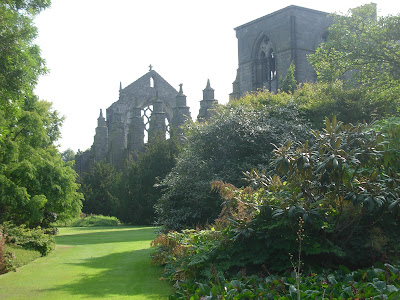Dunrobin castle is not only famous for its beautiful architecture. It is known worldwide because it is the seat of the Clan Sutherland, one of the most powerful clans.
It is the most northerly castle in Scotland and has 189 rooms. Its architecture makes it look like a French castle, but it has been built by an English architect, Sir Charles Barry, best known for the rebuilt of the Houses of Parliament.
Dunrobin Castle is on situated the east coast of the Highlands
overlooking the Moray Firth, just next to the villages of Golspie.
The first architecture which took place in Dunrobin was a Medieval fort. The name of Dunrobin comes from an Scottish Gaelic name ; dun. It means "fort" or "city", and has given the names of London, Donegal, and even Lyon / Lugdunum. The name "robin", comes from of the earls of the castle ; Robert, 6th Earl.
It is only in the 17th century that the place saw the construction of a manor. The Jacobites invaded the castle in 1745 because the Dukes of Sutherland supported the English government. Finally, the castle was transformed into a "Scottish Baronial" type of architecture in 1845. Since 1973, the house is opened to the public, but remains a private house nonetheless, because some rooms are still used by the Countess of Sutherland and her family.
And this is precisely the most interesting point about Dunrobin castle. It has been the seat of Clan Sutherland since the 13th century. The motto of Clan Sutherland is Sans Peur, and appears on the Clan Crest. It is truly the heart of the clan, which is represented all around the world, especially in Northern America. The current chief of the clan is Elizabeth Sutherland, Countess of Sutherland. One of the castle's rooms is occupied by objects and books about the Clan. It keeps the registers of the Clan, indicating the names of all its members. Many Sutherland families come especially to Scotland in order to see those records. Unfortunately, I cannot show you a photo of it because it is forbidden to take pictures inside the castle (because it is a private house).
The gardens :
The main inspiration for these gardens is Versailles in France. They were created by Sir Charles Barry. It practically did not change since then. Every month, the head gardener of the castle publishes a review from the gardens on the castle's website (http://www.dunrobincastle.co.uk/gardens-and-grounds/index.htm).
Daily falconry demonstrations are organised in the gardens. The birds can be seen in a devoted place of the gardens. There is also a small museum showing the trophy heads of the animals shot by family members on safaris.
.jpg)









